|
Memphis
Cotton Carnival |
|
...The
History from
1872 - 2012
|
|
|
|
Click on small photos to
enlarge them. |
|
|
 |
Background:
In 1872, Memphis, along with much of the South, was
suffering from the devastation of the Civil War and
Reconstruction. The city leaders thought that the city needed
a show of civic pride that would bring the residents together
and demonstrate to the outside world that Memphis was alive
and well. They decided on a Mardi Gras celebration to help
re-invigorate the spirits of the public. So Memphis
began to celebrate Mardi Gras, and a big Carnival season was
born, based on the traditional
Christian calendar just before the
season of Lent, similar to what is still practiced in New
Orleans and other cities. This was largely staged by
secret societies, or a “krewe” system, but mostly through the
efforts of the Mystic Society of the Memphi. The societies
held great parades, elaborate balls and parties to
celebrate during this festive season. |
|
1872 Memphis First Mardi Gras |
|
|
|
|
Posters would be put up all over the city and they
would also be shipped to other states and even to
Europe. Not that anyone from Europe ever came
to "Carnival", but at least they knew about the big
celebration in the City of Memphis. This very
rare 1877 Receipt
(on
the right)
is from one of the Carnival founders, Gene Colton
Greene to J. H. Miller, as payment for
"services rendered" in distributing, Carnival
Posters throughout Memphis, and mailing them to
other States, and to Europe. Does $20 seem a
trifle extravagant for the total expenditure for
these services?
>> |
 |
|
|
|
|
During Carnival season, the most coveted invitation of
the year was hand delivered by a servant wearing a white
jacket and all the trimmings. In the book "The
American Plague", Molly Crosby describes the event.
"The envelope was exquisite, large and square, with
golden calligraphy. Inside it took the shape of a
scroll on powder-blue parchment with a regal crown
framing the top where CARNIVAL: MEMPHIS MARDI GRAS
was engraved. Fanning out of Egyptian pyramid, the
secret order of the Ulks and Memphi invited you and your
household to attend pageants March 4 and 5, 1878".
"Over 10,000 people would answer this invitation to
Memphis including, one year, the president of the United
States. As many as 40,000 revelers would stand
shoulder to shoulder along the downtown streets of
Memphis. Harper's would reserve front-page
coverage, sending their best illustrator. The
glitter and glamour of the event was known across the
country, and it was widely whispered that New Orleans
had sent scouts to Memphis to study the parade.
And so began Carnival". |
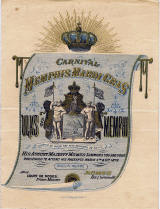 |
|
|
|
|
|
|

Rare Mardi Gras
Medal - 1901
|
However, Memphis experienced the
devastation of a yellow fever epidemic which along with
cholera wiped out much of the city's population. Mardi
Gras celebrations slowly ceased to exist, and by the
late 1890's, the Mystic Memphi and other societies, as
well as the Mardi Gras festivals as a whole were no
longer an active institution in the city.
Fast forward 30 years.
The
Cotton Carnival came about as an event to publicize the
economic heart of Memphis - cotton.
In 1931 Memphis, like the rest of the country, was
suffering through the Great Depression. Many were
out of work and the primary asset of the region -
cotton, was selling for pennies a pound. Mid-South
prosperity had always depended on cotton and
measures were needed to increase the use of this
precious commodity. At the same time, the Memphis
Chamber of Commerce was having trouble raising money to
compete with other cities in the South. |
| |
|
|
|
Arthur Halle and a group of businessmen met with
Herbert Jennings, Loew's State theatre manager to ask
for a donation. Jennings recommended that to help
publicize an upcoming movie, he would offer retailers
space to display cotton goods in his theatre and
encourage them to use their own store windows to promote
cotton clothing. The group was intrigued by the
idea and met with the President of the Cotton Exchange,
Everett Cook. The idea quickly grew into plans for
a grand "cotton celebration" with a King, Queen, and
Royal Court that would involve people from all over the
Mid-South. By promoting the use and wearing of
cotton products, the demand for these products would
stimulate sales. The plan was put into action, and
it worked, as people began to demand more and more
cotton products. |
 |
|
|
|
|
|
|
|
|
|
|
And
the Cotton Carnival
Begins ... |
|
|
|
|
|
|
|
|
|
|
The
newly named "Cotton Carnival" kicked off in 1931 with the riverfront
arrival of the Royal Court on a grandly decorated barge, which
made major use of cotton bales and flags. Afterwards the King
and Queen made their way from the barge to the horse-drawn
Royal Carriage and led the great parade down Main Street.
When the parade was over, the crowds enjoyed a carnival midway that
had been set up on Front Street. This pattern would be
repeated with great success for many years. The theme of the
first carnival was "The Old South", and there were 86 floats in the
parade. P.S. The first carnival was in March and it snowed ... |
|
|
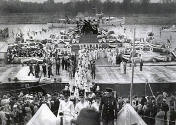 |
 |
 |
 |
 |
 |
|
1931
Royal Barge |
1931
Queen |
1930s
Royalty |
1933
Royalty |
1934
Barge |
1937 Barge |
|
| |
| |
| |
|
Cotton Carnival
became a major festival not rivaled anywhere in the South except
possibly New Orleans, and the event began to incorporate more
than it had originally set out to do. The "South's Greatest
Party" became Memphis' most important and celebrated event.
The arrival of the Royal Barge was the event not to be
missed. The King, Queen, and Royal Court, along with the royal
pages, guards and other participants, would all glide in on a
beautifully decorated and lighted barge on the Mississippi River,
docking at the foot of Union and the historic cobblestones, as an
elaborate display of fireworks filled the night sky. It seemed
that all of Memphis was present at these Royal Barge Landings and
each year the barge designs became more elaborate ... |
| |
 |
 |
 |
 |
 |
| 1930's |
1931 |
1933 |
1938 |
1940s |
|
| |
|
|
|
After
the arrival of the barge, the crowds
would head to Main Street to watch the opening Carnival Parade with
bands and beautifully decorated floats. Because the parade was
late in the evening, and the floats were not electrically lit the
first few years, boy scouts were enlisted to carry flares.
Two scouts holding flares for illumination, walked on each side of
the floats. By 1937 the floats were ingeniously electrified by
using the trolley lines above, which came about by accident.
A few weeks before the 1937 parade all the floats were destroyed in
a fire. The parade was going to be cancelled, but it was
suggested that some of the floats could be rebuilt and electrified
by using old trolley flat- beds and trolley electrical hook-ups.
Thus the electrical parade was born. The earliest floats were
pulled by horses or large mules. It should be noted that later
these early floats were pulled by black men, otherwise blacks didn't
participate in the parade. Later, large trucks pulled the
floats ... |
| |
|
|
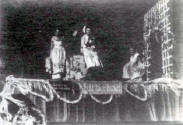 |
 |
 |
|
Commercial Appeal 1931 |
1931
Float |
1931
King-Queen |
1931
Float |
| |
|
|
|
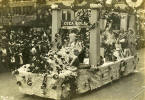 |
 |
 |
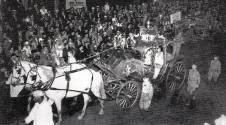 |
|
Vintage float
|
Horse Drawn
Floats 1934 |
Blacks pull
Floats 1930's |
1930's Royal
Carriage |
|
| |
|
|
|
| |
|
|
|
| |
|
|
|
|
|
From
the grand electrical parade, the crowds would
head to the Carnival
Midway set up on Front street for food, rides, games,
and sideshows.
When Front Street was originally developed, the city
planners kept "open spaces" not only for views of the
river, but for use in various community functions.
During most years of the "Memphis Cotton Carnival", in
addition to all the parades and formal festivities,
there was always an "Royal American Shows" carnival
midway for the public and it was set up along Front
Street. In 1973, the midway and other
activities moved to the Fairgrounds ... |
| |
|
|
|
|
 |
 |
 |
 |
 |
|
Poster |
Gypsy Rose Lee - 1949 |
Gypsy Rose Lee - 1949 |
Headliner Gypsy - 1949 |
Side Shows |
| |
|
|
|
|
| |
|
|
|
|
 |
 |
 |
 |
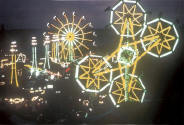 |
|
Midway - 1950s |
1940 |
Rides - 1940 |
Rides - 1940 |
Midway |
| |
|
|
|
|
|
| |
| |
|
Cotton Maker's
Jubilee :
And although not official or in writing, the Cotton Carnival
was a white only affair. In 1935
a Beale Street dentist, Dr. R. Q. Vinson, founded what would become the Cotton
Maker's Jubilee, as a protest to establish dignity and respect
for Negro men and women. It opened with a big parade on Beale Street
and ran concurrently with Cotton Carnival as a parallel
festival. ("...Separate but equal"???) The
Jubilee enjoyed its most successful years from 1948-1958.
The organization briefly merged with Carnival Memphis in 1982
and the name then was Krewe Kemet Jubilee
... |
 |
|
|
|
|
|
|
 |
 |
 |
 |
 |
|
1937
Jubilee Royalty |
1939
Jubilee Royalty |
1956
Jubilee Royalty |
1975
Jubilee Royalty |
1980Jubilee Royalty |
| |
|
|
|
|
| |
|
|
|
|
 |
 |
 |
 |
 |
 |
 |
|
1938 Program |
1940 Program |
1956 Program |
1975 Program |
1980 Program |
1980 Program |
1980 Program |
|
| |
| |
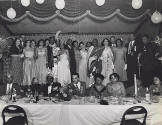 |
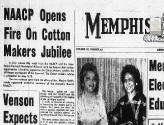 |
 |
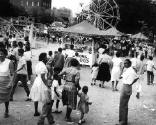 |
|
1951 Jubilee Party |
1961 NAACP opens
fire... |
1937
Parade on Beale St. |
JJubilee
Midway |
|
| |
| |
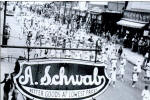 |
 |
 |
 |
|
1938
Cotton Maker's Jubilee |
1940 Cotton Maker's
Jubilee |
Cotton Maker's Jubilee |
Cotton
Maker's Jubilee |
|
| |
| |
| |
|
|
|
|
|
|
|
|
|
|
|
|
|
|
|
|
|
|
After
the carnival had become established, a Maid of Cotton Pageant was
created in 1939 to find a bright and beautiful young lady from any
cotton-growing state, who would travel the world and be a
representative for the cotton industry. She invited the world
to the Cotton Carnival, as she made appearances in her beautifully
designed all-cotton wardrobe. The Maid of Cotton Pageant
became almost as big as the Miss America Pageant and the day parade
was re-named
in her honor
... |
|
|
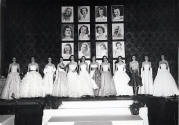 |
 |
|
|
|
Maid of Cotton Pageant |
1950 Maid's Float |
1939 + 1955 Maids of Cotton |
1958 + 1966 Maids of Cotton |
| |
|
|
|
| |
|
|
|
 |
 |
 |
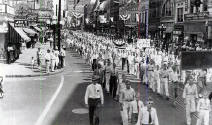 |
|
CBC -1932 |
1936 |
1940 |
1940 |
| |
|
|
|
| |
|
|
|
 |
 |
 |
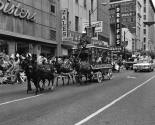 |
|
1930s-Blacks pull floats |
1930s Blacks pull floats |
1950 "Prom" |
1969 Circus Wagon |
| |
|
|
|
| |
|
|
|
 |
 |
 |
 |
|
1940 |
Vintage |
1946 CBC |
Vintage |
| |
|
|
|
| |
|
|
|
 |
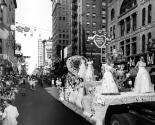 |
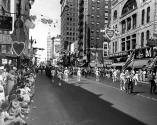 |
 |
|
1969 |
1950 |
1950 |
1969 |
| |
|
|
|
| |
|
|
|
 |
 |
 |
 |
|
1969 |
ROTC 1969 |
1969 |
1969 |
| |
|
|
|
|
 |
 |
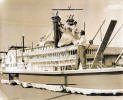 |
 |
|
1950s Band
|
1930s Official Band |
Robt E. Lee 1951 |
1960s Kids March |
| |
|
|
|
| |
|
|
|
|
|
|
|
And
as
the Cotton Carnival grew, a 2nd electrical parade was added -
to close the festivities on the last Saturday. This final
parade might include as many as 30 floats. Throughout its
history
the Cotton Carnival was cancelled only
twice - during the WWII years because Memphis was a
"blackout" city, and again in 1968 after the Martin Luther King
assassination ... |
|
|
 |
 |
 |
 |
|
1966 |
1966 |
1966 |
1966 |
| |
|
|
|
| |
|
|
|
 |
 |
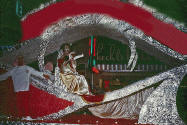 |
 |
|
1966 |
1966 |
1966 |
1966 |
| |
|
|
|
| |
|
|
|
 |
 |
 |
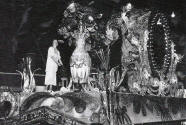 |
|
1946 CBC Band |
1940 |
1940 |
1940s |
| |
|
|
|
| |
|
|
|
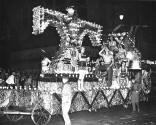 |
 |
 |
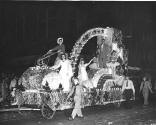 |
|
1946 |
1946 |
1946 |
1946 |
| |
|
|
|
| |
|
|
|
 |
 |
 |
 |
| |
|
1951 |
"Thanksgiving" 1950 |
| |
|
|
|
| |
|
|
|
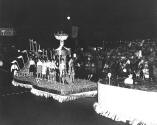 |
 |
 |
 |
|
1960's
|
1946 |
1946 |
1940s |
| |
|
|
|
| |
|
|
|
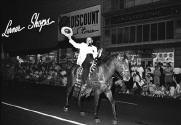 |
 |
 |
 |
| |
|
|
|
| |
|
|
|
| |
|
|
|
|
|
|
|
|
|
|
|
|
|
Within
a few years of the founding of Cotton Carnival, secret societies
known as KREWES
were formed. The Memphi was resurrected from the old Memphis Mardi Gras. Osiris
was formed along the lines of the New Orleans Mystik Krewes.
Shortly afterwards, Sphinx and RaMet were formed. These
organizations functioned to throw lavish private parties and each
had their private party rooms in various downtown hotels. And major
actors from Hollywood were often special guests. Over the years, these
parties
became representative of what Cotton Carnival was all about.
And of course, African Americans were excluded.
While
much of the carnival was dedicated to the private parties and
activities of the secret societies. one thing should be
noted: Whenever the Carnival Association was in
need of funds, these groups pulled out their check
books and asked no questions
... |
|
|
 |
 |
 |
 |
|
1946 Ladies in Waiting |
1940s
with Boss Crump |
1940
Royalty |
. |
| |
|
|
|
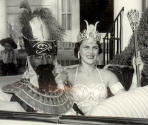 |
 |
 |
 |
|
1954
Osiris Royalty |
|
1950
Royalty |
Two
Carnivals Meet |
| |
|
|
|
|
|
|
 |
The
parades
continued big time up to the early 60s and then began to
slip in quality as well as in attendance.
The assassination of Dr. Martin Luther King,
Jr. left Memphis devastated - especially the state of its
downtown area. Urban sprawl became more common and long-time
businesses
and residents moved away from city center Public events
that were staged by the Cotton Carnival became few and far
between. Parades slowly disappeared, as did the
arrival of the Royal Barge. The Memphis Government
acquired the “float factory” at Mill and Main, where the
decorated floats were manufactured. And Memphians became less interested in this
event. |
|
1954 |
|
|
|
|
|
Eventually
Carnival was left with a series of debutante
parties at private country clubs. The parades were gone
along with the fireworks and the Midway.
The national press had lost interest in the Carnival, and the Maid of Cotton Pageant was
moved to Dallas.
It had taken a long time, but Carnival officials
finally became aware of the negative issues of the
carnival and they began to implement steps to bring outsiders
into the realm. They tried to eliminate carnival's
racial baggage by focusing on private businesses and
charitable giving rather than on the grand parties.
Local Memphis charities were selected to receive
donations.
|
|
|
|
|
| |
|
 |
The 1980’s saw
the Cotton Carnival name changed to the Great River Carnival,
and shortly after that, changed to Carnival Memphis. To
make the festivities more open, the secret societies were recast as Grand Krewes.
The king was now chosen from leaders in other than the
cotton industry. He was no longer called “King Cotton,” but
simply King. The Cotton Makers
Jubilee was merged into one of the Grand Krewes in 1981, but kept its name.
In 1999, the Cotton Makers Jubilee adopted a new name Memphis Kemet Jubilee. Perhaps
the biggest change was the festivities were moved to the month of
June.
Today,
the mission of Carnival Memphis remains the same as it was in
1931 - to recognize and
promote an industry (no longer cotton) that has
economic impact on the Mid-South, and to promote the City of Memphis
as a great place to live and work, and to have an annual
celebration in honor of that industry and the people of the
Mid-South. |
|
The Royal
Barge no longer arrives on the Mississippi to introduce the
King and Queen. There are no longer any official
Carnival parades. But the clubroom private parties of the Grand Krewes still make a glitzy splash during
the month of June.
Yes, the Carnival still exists in Memphis, but the average
younger Memphian doesn't seem to even be aware of it. basically,
it appears that if you aren't part of the Grand Krewes, then
you aren't aware that Carnival Memphis exists. If you
ask the younger Memphian about it, they think you're talking about "Memphis in May", or
the "Beale Music Festival". But ask anyone
who was around
during the 1950s-1960s "What happened to the Cotton Carnival"?
And they'll reply, "The Cotton Carnival is gone. There
aren't any more parades or midway. There's nothing".
And they'll add, "They gave us 'Memphis in May' to replace it"
|
|
|
|
|
|
|
|
|
|
|
|
|
|
|
|
|
|
|
|
Mike Abt
-
Artist, Teacher, Cotton Carnival
Director |
| |
|
Mike Abt, Tech High
teacher and artist, was the guiding force behind all the
barge and float designs for the Memphis Cotton Carnival,
until his death in 1952. He was
particularly noted for the use of brilliant
illumination, which became the highlight of all carnival
parades. Billboard Magazine featured
a nice article about him (below), in 1952.
Mike Abt had brought in his Tech High art students to
decorate the floats in the first 1931 parade. And
throughout the 1940s-1950s, he brought in
art students from all city schools to decorate the floats. It was good
experience for them and free labor for the Carnival
Association. There was never a shortage of student
workers during this period. After Mike Abt's
death, it was only natural that the float designs and overall appearance of the
parades would began to change. In the 1960s, auto
convertibles were added to the parades, a good
indication that the number of floats had decreased.
By the mid 1960s, fewer and fewer high school
students were willing to do this work and the Carnival
Association dropped them altogether and hired a staff to
decorate the floats. |
| |
|
|
|
|
|
|
|
|
 |
 |
 |
 |
|
Mike Abt - C 1935 |
Mike Abt - 1951 |
Billboard
June 28, 1952 |
The
article in Billboard. |
Click to
read |
Click to
read |
|
|
|
|
|
|
|
|
|
|
|
|
|
|
|
|
|
|
|
|
|
|
|
|
|
|
|
|
|
|
|
|
Cotton
Carnival Memorabilia ...
is very collectible |
| |
|
|
|
|
|
 |
 |
 |
 |
 |
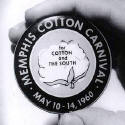 |
|
1947
Flyer |
1933
Ad |
1881 Ad |
1983 |
1947 Program |
1960 Souvenir |
| |
|
|
|
|
|
| |
|
|
|
|
|
 |
 |
 |
 |
 |
 |
|
Carnival Costumes |
Time 1934 |
Transportation Ad |
Carnival Poster |
1950s Decal |
1971 Jazz-Blues |
| |
|
|
|
|
|
| |
|
|
|
|
|
 |
 |
 |
 |
 |
 |
|
Carnival Costumes |
1934
Poster |
1935
Poster |
1936
Poster |
1937
Poster |
Souvenir Plate |
| |
|
|
|
|
|
|
|
|
|
|
|
 |
 |
 |
 |
 |
 |
|
Memphis punchbowl |
Souvenir Glass |
1936 Article |
Coco Cola Cap |
1946
Program |
Carnival Plate |
|
|
|
|
|
 |
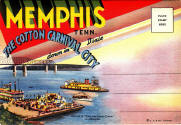 |
 |
 |
|
1955
Flyer |
1935
Postcards |
1938
Sample |
1941 Envelope |
| |
|
|
|
| |
|
|
|
 |
 |
 |
 |
|
Cotton Carnival License |
Postcard
|
1947
Program |
1947 Program |
|
|
|
|
|
 |
 |
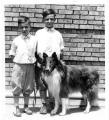 |
 |
 |
|
1946 Perfume Bottle |
1937
Poster |
1928
Pet Parade |
1961
Pet Parade |
Carnival Calendar |
|
|
|
|
|
 |
 |
 |
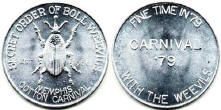 |
 |
 |
| 1940s
Doll |
1973 |
Leslie's 1878 |
Carnival Medals 1979 |
Thermometer |
License |
|
|
|
|
|
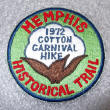 |
 |
 |
 |
 |
 |
|
1972 Patch |
1974 Patch |
1975 Patch |
Mystic Society |
1939 Maid |
Maid Music |
|
|
|
|
1935 Cotton Carnival Souvenir Program
=>
Click
on Program Cover to see the individual pages from this Program. |
 |
|
|
|
|
|
|
|
|
|
 |
 |
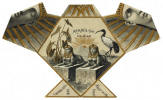 |
 |
 |
| Vintage
Invitation |
18188484 |
1888 Invitation front > |
< 1888 Invitation back
|
1890
Invitation |
|
|
|
|
|
|
|
|
|
|
|
|
|
| 1876
Program |
< Page 2
|
Page 3 |
Page 4 |
Page 5 |
Page 6 |
Page 7 |
Page 8 |
9 |
1876
Ticket |
|
|
|
|
|
 |
 |
 |
 |
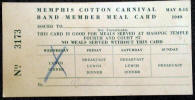 |
| 1877
Parade Sketches |
Mardi
Gras Dance Cards |
1956
Medal |
Sally
Rand Midway 1940 |
Band
Meal Ticket 1949 |
|
|
|
|
|
 |
 |
 |
 |
 |
 |
 |
|
1946 Billhead |
Poland Photo |
1960 Button |
1938 Banner |
1948 program |
1875 Review |
Ethel
Vinson |
|
|
|
|
|
 |
 |
 |
 |
 |
| 1941
Program |
1947 |
1872
Mardi Gras |
1937 Pin |
1931
Transportation Promotion |
|
|
|
|
|
|
|
|
|
|
|
Confessions
of a Carnival Float Decorator... |
|
-
Gene Gill, Webmaster,
"Historic Memphis" 2012 and Float Decorator 1948-1952 |
|
|
|
Memphis used to be a parade town. The
love for parades went back to early Memphis history
when the city
threw so many parades that a respectable new parade
could be arranged at the slightest
suggestion. When Cotton Carnival became an
official part of the Memphis Calendar in 1931, it was
only natural for the city to include great parades.
The parades became such an important part of the
year that a special "Memphis Cotton Carnival" building
was built
at the corner of Mill and Main. Those of us who
worked there simply called it "the float
building". It was a huge
barn-like structure with a tin roof and all the city's
floats were designed, built, decorated, and stored
there. Building floats became a year-round operation because
in addition to carnival, the city began holding parades on
Thanksgiving, Christmas, sometimes on Armistice
Day-Veterans Day and the 4th of July. But the main
parades were those for Cotton Carnival. There were
generally two night parades and 1 day parade - and each
of them was made up of roughly 15 to 30 floats. |
| |
|
|
I began my tenure at the "float building"
during the
10th grade at Tech High School in 1948. As the new
kid on the block, I had to learn the ropes by working
on someone else's float for at least one parade.
My first parade was a Christmas Parade and I took
to the job immediately, as well as to the new terminology.
"Flitter" was the sparkling "glitter".
"Puffing" was the crumpled tissue paper which
looked soft and cloud-like. It was puffed on the float floor with wheat paste - which we
mixed ourselves. Large sheets of metallic
colored foil had to be wrinkled to reflect light
and had to be adhered to the sides of floats with
molasses.
|
 |
|
My
First Float |
|
I already knew about Papier
Mache - but not on such a grand scale. And I
also already knew how to use Tempera Paint - the
only paint used on the floats. The photos
below were taken with the first camera I
ever owned. The quality is not very good,
but very few of us at this time even had a camera
... |
|
Cotton Carnival floats were designed by several
professional artists and sometimes by senior
artists from the Memphis Academy of Arts.
"Sponsors" of floats were the "royalty" of the
float building and usually got to pick the design
of their choice- These sponsors were high school
art students who became responsible for finding the workers to help
with the decorating, supervising their work,
designing the costumes, assigning the riders on the
float, and seeing that the float was finished on
time. High School students who worked on the
floats got out of school at 2 PM and could work as
late as 9 PM. Some students worked only two hours every day - some stayed late.
I was usually there until near 9 PM ...
|
| |
|
|
|
|
 |
 |
 |
 |
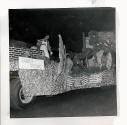 |
|
"Hawaii" |
"Hawaii" |
"Happy
Motoring" |
"Halloween" |
"Hawaii" |
| |
|
|
|
|
|
Working dail and staying late paid off,
because after working on just the one Christmas
parade float I was allowed to Sponsor a float.
Sponsors had an additional responsibility.
When workers needed more material such as paint, brushes, foil,
paste, etc., the sponsor had to check
out these materials for the them. The staff
quickly learned which sponsors did the most work
and which ones were the least wasteful. For
all of this responsibility, the sponsor received a BIG perk - a
"dinner-chit" for thirty five cents - honored at a
"hamburger restaurant" a couple of blocks away
where we ate dinner. All the workers got was
to be on the float during the actual parade.
But that was fun!
From 1948 through1951, I was a regular fixture at
the float building and sponsored floats
in every parade for those years. And this
included a float in the Thanksgiving Parade, the
Christmas Parade, the Armistice Day Parade, and
one 4th of July Parade, in addition to the Cotton
Carnival floats. Even after graduation in
1951, I returned during my first year at Memphis
State ... |
| |
|
|
|
|
 |
 |
 |
 |
 |
|
Freedaom of Religion |
Freedaom of Religion |
"South of the Border" |
"Valentine's Day" |
"New Years" |
| |
|
|
|
|
 |
 |
 |
 |
 |
|
"Christmas" |
Santa's Float |
"Thanksgiving" |
|
"Alice in Wonderland" |
| |
|
|
|
|
|
COSTUMES: As
a float Sponsor, you either had to design or see
that the costumes for your float were designed.
There was no internet for research. Since
most float themes were historical, we researched
at the library or "made it up". The designs
were turned in to a carnival employee.
Several weeks before the parade, they would call
us in and give us the fabric for the designs.
They stocked every color of a basic cotton fabric,
a basic net fabric, and ribbons, including
metallic. That's it. Everyone who wore
a costume was responsible for seeing that it got
made and it was up to them if they wanted to
splurge a bit and use use a better quality fabric.
It was amazing to see how clever the
workers were in creating their costumes ...
|
| |
|
|
|
|
|
 |
 |
 |
|
|
Pilgrim - Centurian |
"Tojo" |
Winter - Hawaii -
Matador |
| |
|
|
|
|
My "dream-float" was "Madam
Butterfly" in 1951. It was a beautifully
designed float by a recent Art Academy graduate .
On the front was a large gold cherry tree in full
bloom. Toward the middle was a Japanese Moon
Bridge. At the back was a beautifully
designed Temple with delicate screens on each
side. This design was so beautiful that I
wanted it to be perfectly decorated. We
figured out a way to create the cherry blossoms by
using pink crepe paper combined with pink
cellophane. Each piece had to be twisted and
then wired together so they could be wired to the
tree. I needed over 200,000 blossoms.
That was a good job for my "workers" - and they
totally hated me for it - but hey, someone had to
do it. Meanwhile, I was doing the |
 |
|
fun part -
decorating that gorgeous Japanese bridge and
temple. About a week before the parade, Mike Abt came over while I was working and said, "Gene,
this is the most beautifully decorated float that
we've ever had". I lived for months on that
compliment. I've always regretted
that, to
my knowledge, there's actually no photo of this float
anywhere. |
| |
|
A few days before the parade in 1951, the building
staff threw a
dance party for the workers.
This was the only time that happened during my 4
years. We had food, music, and dancing.
We also had a floor show and we were it.
Mike Abt began the ceremony by announcing that we
were forming a new Secret Society of Carnival
Surfs, and needed a King, Queen, and Royal Court.
They had been selected by secret ballot and he was
going to announce them. I was named King
Foil. My crown was a paint bucket made of
card board, My scepter was a huge paint
brush. And they had borrowed the robes from
previous carnival royalty and draped those over my
shoulder. My throne was a wheat paste
barrel. And then the Queen "Flitter" and the
Royal Court were announced. We were all very surprised with this.
Great fun!
Plus, we got photos in the newspaper ... |
| |
|
|
 |
 |
 |
|
Mike Abt |
Society of
Carnival Serfs - Commercial Appeal |
Society of Carnival
Serfs |
|
| |
|
|
|
|
|
Another part of the ceremony was drawing names to
attend one of the Secret Society parties during carnival
week, in the downtown hotels. Four of us drew "Osiris".
And of course, at the Osiris party in the Claridge Hotel, we
were part of their entertainment, but I saw it the other
way and loved every minute of it. At the time,
Memphis was a dry city, but alcohol could be served at
private parties. Osiris served the four of us a
glass of Champaign (15 -17 years old). Wilbur
Weaver tasted his Champaign and frowned. Charles
and Mary Nell ignored theirs. Although I had never
tasted alcohol before, I drank all of mine.
...and have loved Champaign ever since. |
| |
|
PARADE DAY You arrive at the float building
about 1 to2 hours prior to the parade. All the
floats are now lined up on Main Street outside the Float
Building. Little by little your "cast members"
arrive and you see their costumes for the first time.
You're not always pleased (Why can't they follow my design
pattern?). The few who have cameras take a
few photos as you wait for darkness. At the magic
hour, the float lights are turned on. The thrill
of seeing all the floats electrified for the first time
never ends. It is magic! The parade begins
and all is good and it was worth all the work.
Next year will be even better. |
| |
|
More scenes around the float building... etc ... |
| |
 |
 |
 |
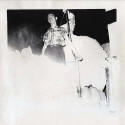 |
 |
|
Commercial Appeal |
Commercial Appeal |
Float
Building |
Gene
- Turkey |
Robert E. Lee Float |
| |
|
The "float building" was actually the Cotton
Carnival Association at 547 N. Main. The plain
barn-like building was huge because it had to
accommodate all the floats for 3 parades (2 night
parades and 1 day parade). And it also
contained work shops and design studios, as well as
offices. Today this is the Main Street Trolley
Building, used for restoring and maintenance of all
the antique trolleys that have returned to Memphis.
> |
 |
|
- Gene
Gill, February 2012 |
547 N. Main today |
|
| |
|
|
|
|
|
|
|
|
|
|
Credits |
|
|
|
The
Historic-Memphis website does not intentionally post copyrighted
photos and material without permission or credit. On
occasion a "non-credited" photo might possibly be posted because we
were unable to find a name to give credit. Because of the nature of
our non-commercial, non-profit, educational website, we strongly
believe that these photos would be considered "Fair Use. We have
certainly made no monetary gain, although those using this website
for historic or Genealogy research have certainly profited. If by
chance,
we have posted your copyrighted photo, please contact us, and we'll
remove it immediately, or we'll add your credit if that's your
choice. In the past, we have found that many photographers
volunteer to have their works included on these pages and we'll
also do that if you contact us with a photo that fits a particular
page. |
|
|
|
The "Historic-Memphis" website would like to acknowledge and thank the
following for their contributions which helped make this website
possible: Memphis
Public Library, Memphis University Library, Memphis Law Library,
Memphis Commercial Appeal, Memphis Press Scimitar, Shelby County
Register of Deeds, Memphis City Schools, Memphis Business Men's
Club, Memphis Chamber of Commerce, Memphis City Park Commission,
Memphis Film Commission, Carnival Memphis, Memphis Historical
Railroad Page, Memphis Heritage Inc, Beale Street Historic District,
Cobblestone Historic District, Memphis Historic Districts, Vance
Lauderdale Family Archives, Tennessee State Archives, Library of
Congress, Kemmons Wilson Family, Richard S. Brashier, Lee Askew,
George Whitworth, Woody Savage and many individuals whose assistance is
acknowledged on the pages of their contributions. Special
thanks to Memphis Realtor, Joe Spake, for giving us carte blanche
access to his outstanding collection of contemporary Memphis photos.
We do not have high definition copies of the photos on these
pages. If anyone wishes to secure high definition photos,
you'll have to contact the photographer or the collector.
(To avoid any possibility of contributing to SPAM, we do not
maintain a file of email addresses for anyone who contacts us). |
|
|
|
|
|
|
|
|
|
|
|
|
|
|
|
|
|
|
| |
| |
|
|
|
|
|